My Most Thrilling Sky Fight: Captain Charles Nungesser
Amidst all the great pulp thrills and features in Sky Fighters, they ran a true story feature collected by Ace Williams wherein famous War Aces would tell actual true accounts of thrilling moments in their fighting lives! This time we have French Flyer Captain Charles Nungesser’s most thrilling sky fight!
Of all the great French Aces, 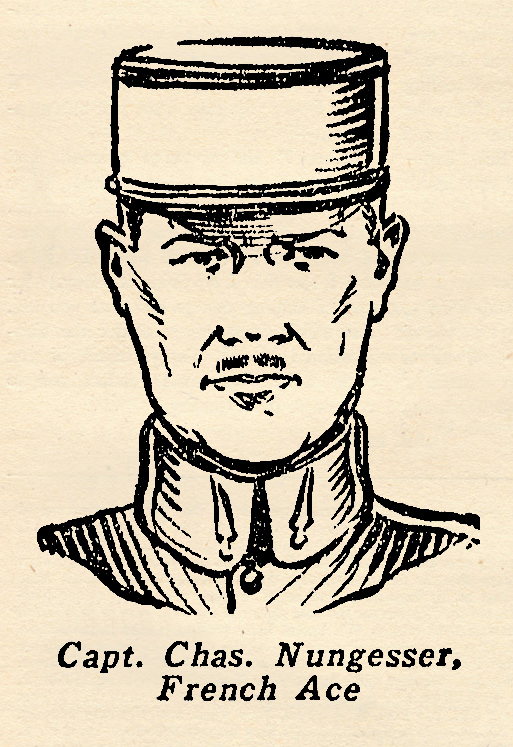 none is more poignantly remembered than Charles Nungesser, who began his flaming war career as a Lieutenant of Hussars and was one of that famous lighting band of cavalrymen that stopped the German Uhlans at the gates of Paris. For his exploits in this heroic stand he was awarded the Medal Militaire, the highest combat award.
none is more poignantly remembered than Charles Nungesser, who began his flaming war career as a Lieutenant of Hussars and was one of that famous lighting band of cavalrymen that stopped the German Uhlans at the gates of Paris. For his exploits in this heroic stand he was awarded the Medal Militaire, the highest combat award.
But horses were too slow for this daring, dashing young officer. He transferred to aviation and was trained as a bombardment pilot, after which he took part in thirty-eight bombing raids across the German lines, before his unusual flying ability was recognized and he was sent on to a chasse squadron—Nieuport 65.
Nungesser was wounded seventeen different times, but in between times in the hospital managed to run up a score of forty-one victories and was awarded every decoration possible.
Ten years after the war’s end, Nungesser, with a colleague, Major Coli, took off from Paris on an attempted non-stop flight to New York. His plane disappeared into the blue and no trace of either Nungesser, his colleague, or the wreckage of the plane has ever been found. Thus ended the flaming career of one of the greatest of all sky fighters. His own story of a thrilling battle as recorded by a French journalist, follows.
A STRANGE VICTORY
by Captain Charles Nungesser • Sky Fighters, June 1935
ALL duels du ciel are thrilling—some in one way, others in another. It is thrilling to down an enemy after pouring burst after burst into his avion. Many times I have done that, but I think it is even more thrilling, more exciting, and certainly more unique when one downs an enemy avion without firing a single shot. I have done that—in fact, I didn’t even have guns on my avion, let alone bullets. I shall tell you about that.
The motor of my avion had been acting up. The mechanic came to me when he had repaired it, and I said I would take it off for a test flight. I did, went way up into the blue above the clouds to 5,000 meters. The motor was splendid. I sailed around absent-mindedly enjoying the beautiful view, when lo and behold, a Boche avion breaks into the clear space beneath me.
Ready for Battle
It is a two-seater, less than thousand meters away. I dip and go for him, but he sees me before I reach firing range. The gunner in back stands up and swings his mitrailleuse on me. Tack-tack! He puffs a short burst. I slip under it and dive faster, my own fingers poised on the trigger trip—ready to give it to him when I get closer.
I get closer, close enough! The Boche is clear in my sight. I press the trigger— but nothing happens! Another burst from the Boche gunner flicks through my wings. My own gun is jammed, I think. I reach up to clear it, still holding on the Boche’s tail.
But Mon Dieu—I have no gun! The cradle is empty!
I am almost about to crash the other’s tail now. He has to dive to get away. I see the rear gunner standing up in his seat. He is fumbling with his gun. It has jammed. Terror is on his face. The Boche pilot dives and zig-zags to get out of my range. I keep pressing close on top, pushing him down in a long steep spiral.
Waiting for the End
The rear gunner gives up, folds his hands complacently and waits for my bursts to snuff his life out. Down and down we spiral, through the clouds, out underneath. The gunner fumbles at his mitrailleuse again, I decide to run my bluff, hoping that I can force them to land before the gunner clears.
Voila! I do. The Boche pilot spies a clear space and sets down. I circle and land beside them, but I am helpless when they set fire to their machine. I have no guns to prevent it.
Poilus surrounded the burning avion and took the two Boches prisoners. Both were very mad and swore profanely when they found out I had no guns on my avion. But it was another victory for me, the most unusual one! The armorer had removed my gun to clean, when my avion was laid up for repairs. I had neglected to see that it was in place before I took off.





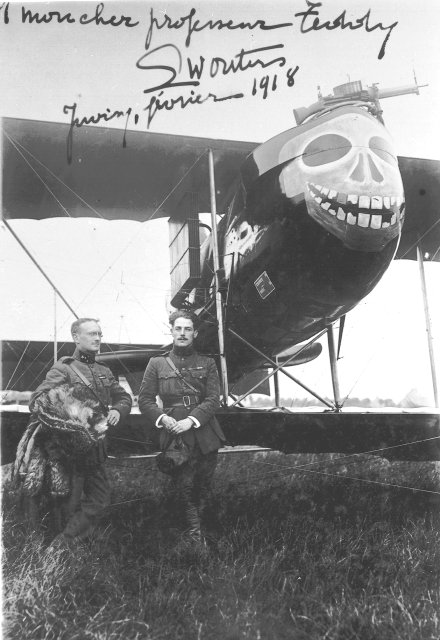
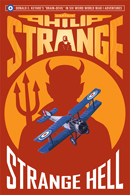 of Donald E. Keyhoe’s Philip Strange tales in the latest volume of his collected adventures—
of Donald E. Keyhoe’s Philip Strange tales in the latest volume of his collected adventures—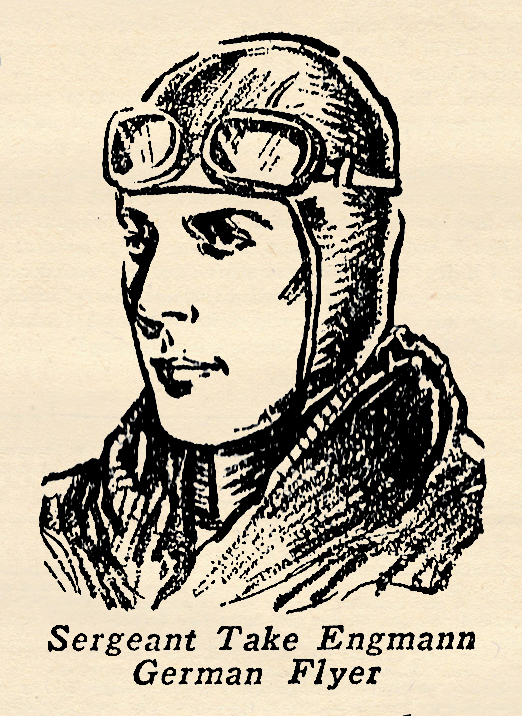 air did not fly single-seater fighting planes, and all of the heroes did not accomplish their missions single handed. Some of the great feats were accomplised by the pilots of the bigger, bulkier, clumsier, two and three-seater observation and bombing planes. Sergeant Engmann was one of the heroes of this latter class. Obscure, reticent, retiring by nature, his own part in the many successful missions accomplished by the greatest of all German observation aces, Captain Heydemarck, whose pilot he was, marks him as one of the outstanding flyers of the war.
air did not fly single-seater fighting planes, and all of the heroes did not accomplish their missions single handed. Some of the great feats were accomplised by the pilots of the bigger, bulkier, clumsier, two and three-seater observation and bombing planes. Sergeant Engmann was one of the heroes of this latter class. Obscure, reticent, retiring by nature, his own part in the many successful missions accomplished by the greatest of all German observation aces, Captain Heydemarck, whose pilot he was, marks him as one of the outstanding flyers of the war.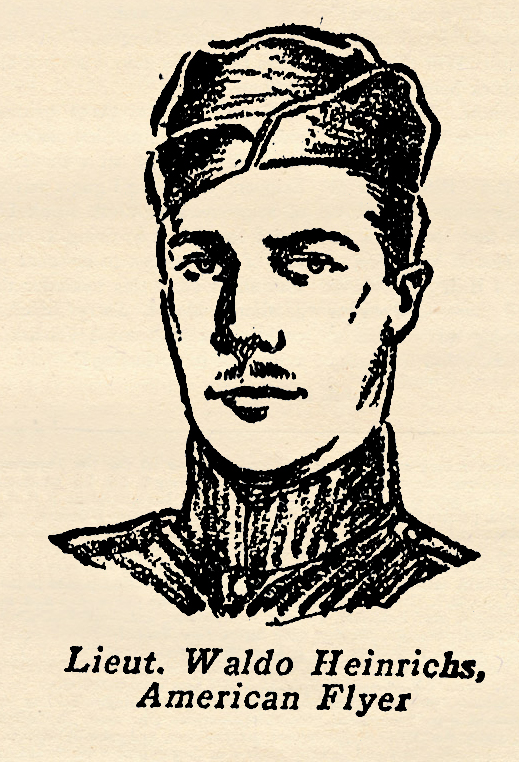 the first contingent of flying cadets to be graduated from the air combat school at Issoudun, France, the great flying field established by the American Air Service on foreign soil after the United States entered the war. He was one of tho original members of the famous 95th Pursuit Squadron, the first American squadron to do actual front line duty with the American Army. Among his squadron mates in the 95th were Lieutenant Quentin Roosevelt and Lieutenant Sumner Sewell.
the first contingent of flying cadets to be graduated from the air combat school at Issoudun, France, the great flying field established by the American Air Service on foreign soil after the United States entered the war. He was one of tho original members of the famous 95th Pursuit Squadron, the first American squadron to do actual front line duty with the American Army. Among his squadron mates in the 95th were Lieutenant Quentin Roosevelt and Lieutenant Sumner Sewell.



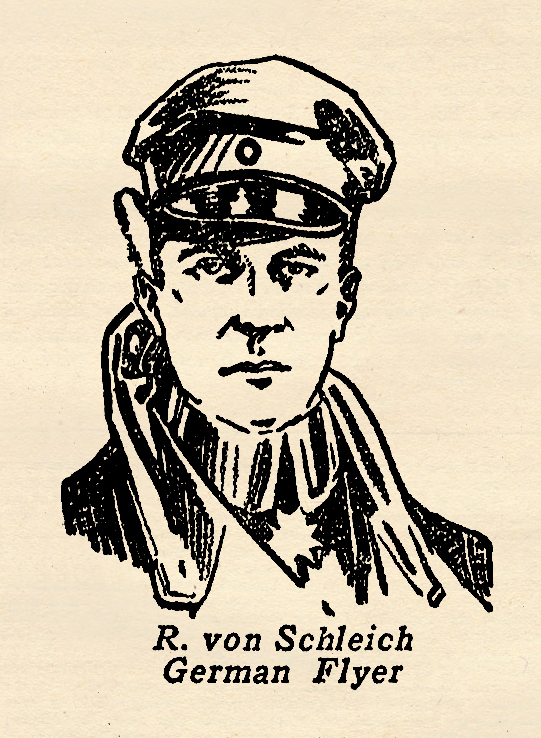 of the least known, but nevertheless, one of the greatest and most successful of the German war birds. A nobleman by birth, he was educated for service in the army beginning with his early childhood. When the war broke out he was an officer in the Uhlans, the most aristocratic branch of the German Army. After transferring to the flying corps, he served some time as an observer, before learning to become a pilot himself; paralleling in that respect the career of Baron Manfred von Richthofen, who preceeded him as an officer of Uhlans.
of the least known, but nevertheless, one of the greatest and most successful of the German war birds. A nobleman by birth, he was educated for service in the army beginning with his early childhood. When the war broke out he was an officer in the Uhlans, the most aristocratic branch of the German Army. After transferring to the flying corps, he served some time as an observer, before learning to become a pilot himself; paralleling in that respect the career of Baron Manfred von Richthofen, who preceeded him as an officer of Uhlans.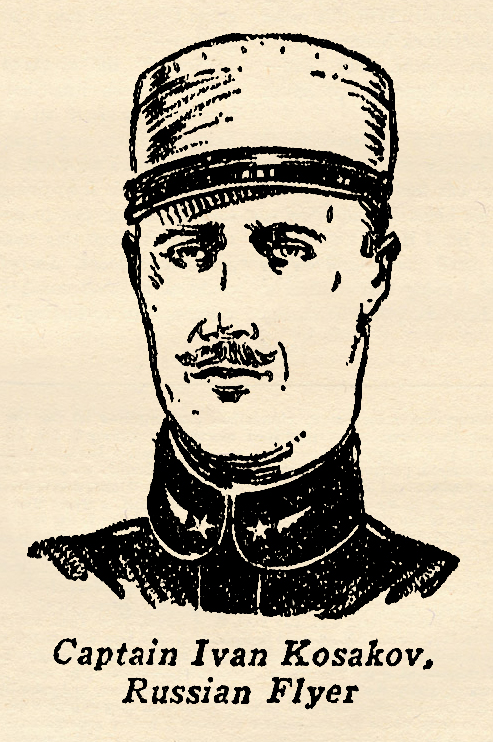 a great war hero when lie transferred from the cavalry to the flying corps. After a short course of just two weeks in flying school, he was sent up to the front again as a bombardment pilot. But flying heavy, unwieldy bombers was too slow and tedious work for him. He was transferred to a single-seater fighting squadron after two months with the bombers. It was then that his remarkable record began to grow.
a great war hero when lie transferred from the cavalry to the flying corps. After a short course of just two weeks in flying school, he was sent up to the front again as a bombardment pilot. But flying heavy, unwieldy bombers was too slow and tedious work for him. He was transferred to a single-seater fighting squadron after two months with the bombers. It was then that his remarkable record began to grow.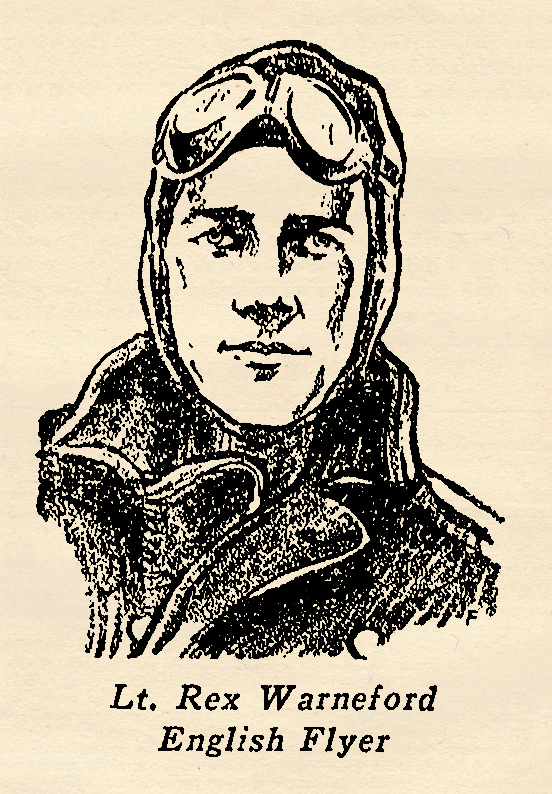 of the British Royal Flying Corps was the first airman to shoot down an enemy Zeppelin, likewise he was the first war pilot to win the coveted Victoria Cross. Previous to his epic fight with the raiding Zeppelin young Warneford was a comparatively obscure pilot. After this amazing and brilliant victory he leaped to the highest pinnacle of fame, he escaped from the German lines with his plane after being forced down fully five miles from his own territory. A troop of German cavalrymen rode up to take him prisoner, but using his machine-gun to the greatest advantage he managed to hold them off until he had completed temporary repairs on his plane. Then, amidst a continual hail of fire, he took off in flight, running the gauntlet of fire successfully, eventually to land within his own lines. Unhappily, two days after the V.C. had been conferred on him, he was killed in an air accident near Paris. In the account below he tells the story of this fight in his own words:
of the British Royal Flying Corps was the first airman to shoot down an enemy Zeppelin, likewise he was the first war pilot to win the coveted Victoria Cross. Previous to his epic fight with the raiding Zeppelin young Warneford was a comparatively obscure pilot. After this amazing and brilliant victory he leaped to the highest pinnacle of fame, he escaped from the German lines with his plane after being forced down fully five miles from his own territory. A troop of German cavalrymen rode up to take him prisoner, but using his machine-gun to the greatest advantage he managed to hold them off until he had completed temporary repairs on his plane. Then, amidst a continual hail of fire, he took off in flight, running the gauntlet of fire successfully, eventually to land within his own lines. Unhappily, two days after the V.C. had been conferred on him, he was killed in an air accident near Paris. In the account below he tells the story of this fight in his own words: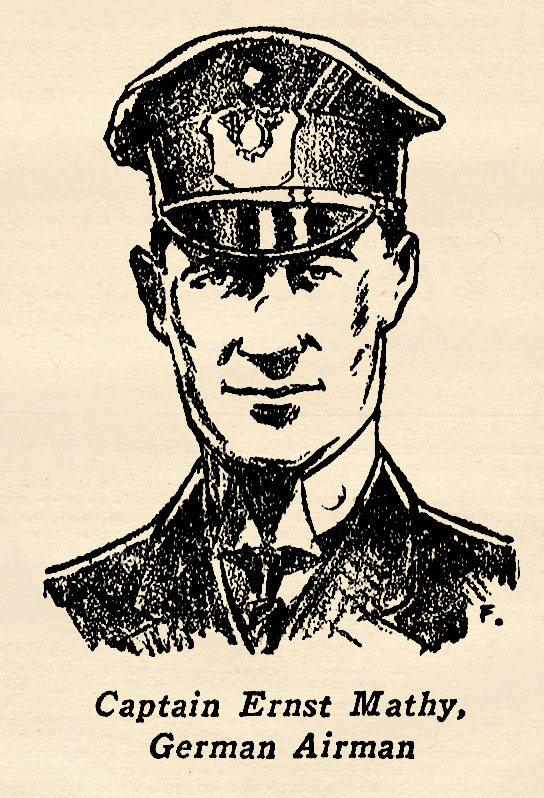 the Zeppelin raiders as told by the raiders themselves have come out of the Great War. Captain Ernst Mathy was one of the most famous of all wartime Zeppelin commanders, having made before he was killed in his final raid over London, six successful night raids over that well protected city, more than any other Zeppelin commander. It was Captain Mathy who developed and perfected most of the strategy of attack for the giant Zeppelins operated by the Imperial
 Flying Corps.
the Zeppelin raiders as told by the raiders themselves have come out of the Great War. Captain Ernst Mathy was one of the most famous of all wartime Zeppelin commanders, having made before he was killed in his final raid over London, six successful night raids over that well protected city, more than any other Zeppelin commander. It was Captain Mathy who developed and perfected most of the strategy of attack for the giant Zeppelins operated by the Imperial
 Flying Corps.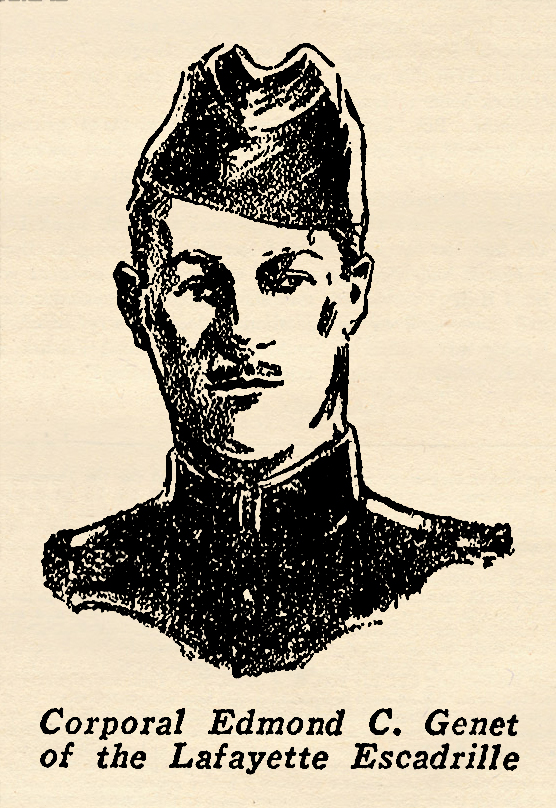 Citizen Genet, who served as the revolutionary ambassador from France during George Washington’s term as president, Edmond C. Genet had a distinguished heritage. Mild-mannered and handsome he was a typical soldier of fortune at heart, possessing an astonishing courage. At 10 he missed an appointment to Annapolis and immediately enlisted in the navy where he participated in the taking of Vera Cruz. A year later he was in battle in Haiti. Later on after the war in Europe broke out, he sailed for France to enlist in the Foreign Legion. He served for some years in the trenches as a simple poilu, then was transferred to aviation and assigned to Escadrille N-124, better known as the Lafayette, where he was the youngest American in a company of famous men. Genet’s flying time on the front was short. He was one of the few airplane pilots to be killed in the air by enemy shrapnel. He was the first American to die in action under the stars and stripes, his death occurring just ten days after America entered the war. The account below is from one of his letters home.
Citizen Genet, who served as the revolutionary ambassador from France during George Washington’s term as president, Edmond C. Genet had a distinguished heritage. Mild-mannered and handsome he was a typical soldier of fortune at heart, possessing an astonishing courage. At 10 he missed an appointment to Annapolis and immediately enlisted in the navy where he participated in the taking of Vera Cruz. A year later he was in battle in Haiti. Later on after the war in Europe broke out, he sailed for France to enlist in the Foreign Legion. He served for some years in the trenches as a simple poilu, then was transferred to aviation and assigned to Escadrille N-124, better known as the Lafayette, where he was the youngest American in a company of famous men. Genet’s flying time on the front was short. He was one of the few airplane pilots to be killed in the air by enemy shrapnel. He was the first American to die in action under the stars and stripes, his death occurring just ten days after America entered the war. The account below is from one of his letters home.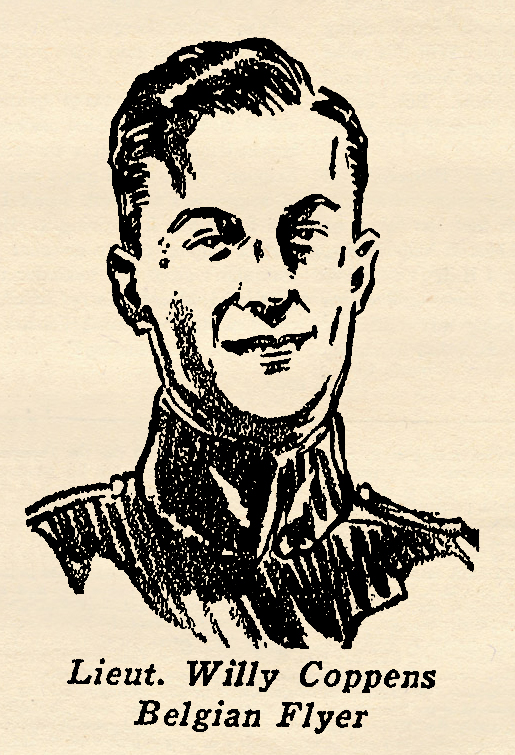 Belgian Ace of Aces. He got his initial training as a soldier and officer in the cavalry division of the army. He transferred later on to the Flying Corps and began immediately to compile the record of victories that gained him top ranking among sky fighters.
Belgian Ace of Aces. He got his initial training as a soldier and officer in the cavalry division of the army. He transferred later on to the Flying Corps and began immediately to compile the record of victories that gained him top ranking among sky fighters.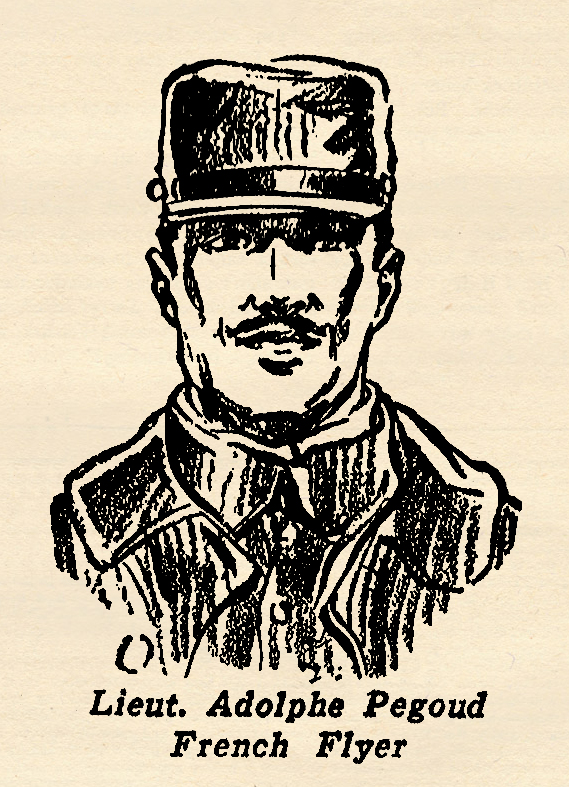 famous flyer before the war began. In 1913, flying a tiny Bleriot monoplane, he astonished the world by doing a series of intricate air maneuvers. Later, he made an upside down landing, the first and to this day the only aviator deliberately to perform such a stunt.
famous flyer before the war began. In 1913, flying a tiny Bleriot monoplane, he astonished the world by doing a series of intricate air maneuvers. Later, he made an upside down landing, the first and to this day the only aviator deliberately to perform such a stunt.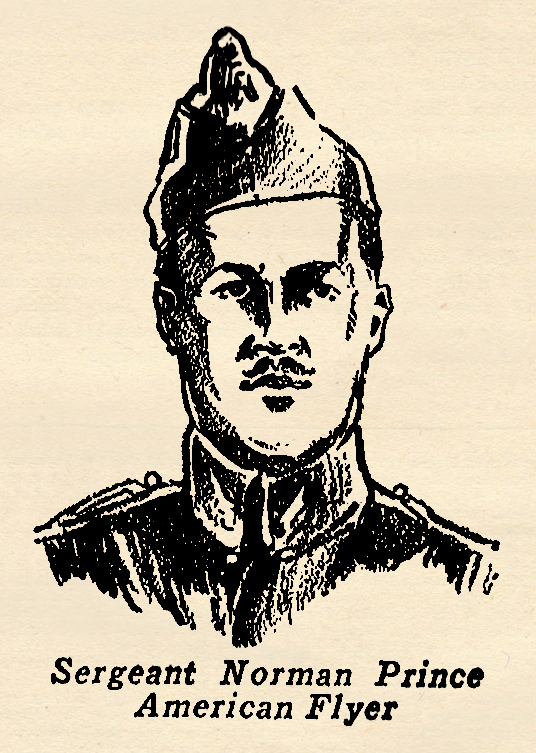 France when the World War began. Being immensely wealthy in his own right, he offered to furnish and equip an entire squadron of planes and pilots. The French Army would not accept this generous offer, but Prince, acting in co-operation with William Thaw of Pittsburgh, convinced the officials that they could muster enough Americans to man an entire squadron. Their offer was accepted, and the LaFayette Escadrille was born. A French officer was put in command. All the rest of the pilots were American. Prince’s death was tragic. Though wounded in an air battle, he managed to fly his crippled plane homeward, and was about to land on his own airdrome in the gathering darkness when his plane ran into a telephone pole and crashed. In his weakened condition he did not have strength enough to guide his plane over or around the obstacle. So perished one of the bravest and most courageous of the early American pilots who gave their lives for France. The story below was told to a French reporter.
France when the World War began. Being immensely wealthy in his own right, he offered to furnish and equip an entire squadron of planes and pilots. The French Army would not accept this generous offer, but Prince, acting in co-operation with William Thaw of Pittsburgh, convinced the officials that they could muster enough Americans to man an entire squadron. Their offer was accepted, and the LaFayette Escadrille was born. A French officer was put in command. All the rest of the pilots were American. Prince’s death was tragic. Though wounded in an air battle, he managed to fly his crippled plane homeward, and was about to land on his own airdrome in the gathering darkness when his plane ran into a telephone pole and crashed. In his weakened condition he did not have strength enough to guide his plane over or around the obstacle. So perished one of the bravest and most courageous of the early American pilots who gave their lives for France. The story below was told to a French reporter.

